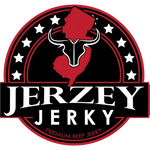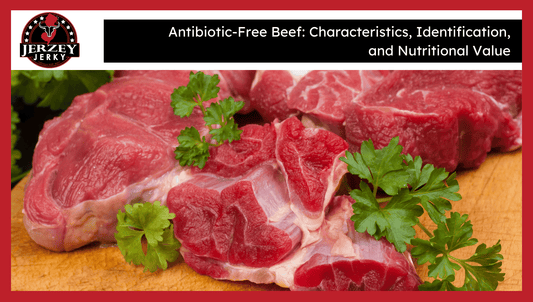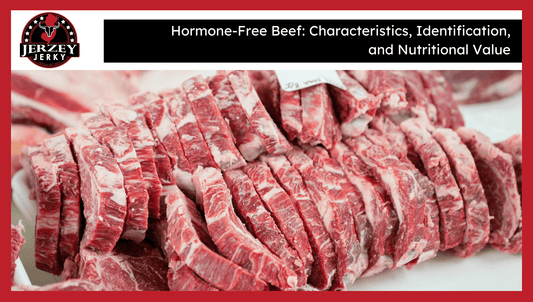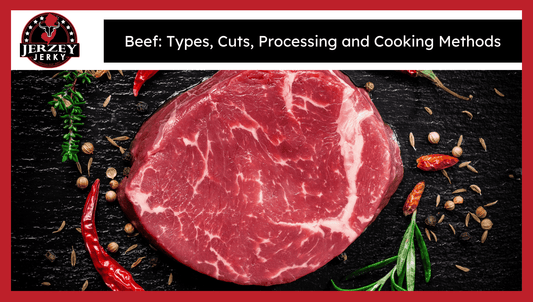
Grass-Fed Organic Beef Jerky Recipe
Grass-fed organic beef jerky is made of lean beef cuts of grass-fed beef produced without antibiotics or growth hormones. A 2014 study published by the University of Minnesota, Department of Animal Science, finds that grass-fed beef has 5 times more omega-3 fats than grain-fed beef.
Pasture-based feeding retains the flavor as more earthy and richer. This beef produces jerky that has a smoky/slightly sweet flavor, contains less grease and fewer additives. It can be chewy and tender with a natural rich umami.
This jerky is famous among hikers, sportsmen, and snack lovers for its high content. In 2023, as reported by the USDA, more than 12 million Americans chose jerky with organic, grass-fed meat due to its clean label and nutrient-dense content.
What are the Ingredients of Grass-Fed Organic Beef Jerky?
Here are the nine ingredients of grass-fed organic beef jerky:
- 500g sac de meat beef de breed grass-fed organic (top round, sirloin tip, or flank steak)
- 60 ml organic tamari or coconut aminos
- 30ml organic apple cider vinegar
- 1 tsp Organic Garlic powder
- 1 tsp of organic onion powder.
- 1 tsp coarsely ground black pepper
- 1 tsp smoked organic paprika Spice
- 1 tbs Himalayan pink salt or sea salt
- 1/2 tsp organic red pepper flakes (optional)
Marinade Preparation
Use the Frozen/Frosty beef. Chill it (to gain a firm consistency) within 60 minutes. This maintains evenness of slices and does not tear soft muscle fibers when sliced.
Cut off all protrusive fat on the meat. Fat leads to deterioration and reduces the shelf life of jerky. Lean meat does not rot and dries quickly.
Cut the beef using a sharp knife into uniform pieces of beef. Cut 1/8 to 1/4 inch thick. Cut across the grain to get firm chewy results. Cut the grain to eat tender.
Place the strips on a clean surface and press them with paper towels. This dries the surface moisture and makes the meat hold the marinade better.
Even drying also requires even thickness. Maintain strip sizes the same. Irregular cuts also dry at various rates and make under-dried pieces a possibility.
Cutting & Preparation
Put the beef in the freezer for 1 hour. Freezing contributes to a slight firmness and facilitates uniform slices to be made without rupture of muscular fibers.
Cut off all fat and slack with a sharp knife. Fat goes rancid in storage and affects jerky shelf life. Remember to take this off before cutting.
Cut the meat into strips 1/8 to 1/4 inch thick. To have a soft texture cut with the grain. To make it into tender morsels, pass across the grain.
Take out each strip into a flat form and squeeze using paper towels. Drying removes moisture on the surface and assists in hastening dehydration. High moisture slows the drying and makes it prone to spoilage.
Make all the slices the same in thickness. Inconsistent pieces take various amounts of time to become dry and produce variations in the final jerky batch.
What are the Drying/Cooking Methods for Grass-Fed Organic Beef Jerky?
Use a dehydrator with a 160°F setting. Leave the strips to dry which takes between 4 and 6 hours. The jerky is to be dry but not brittle to break.
Lay strips on a wire rack in an oven on a baking sheet. Cook at 170 degrees or as low as possible. Do not close the oven door thoroughly. Drain-dry 4 6 hours.
You can optionally use a smoker using natural hardwood such as applewood or cherry. Cook the meat slowly over low heat and smoke for 2-3 hours. This also provides a natural smoked taste with no additives.
Safe dehydration and the best texture all methods need to be provided with equal temperatures and time. Homogenized drying lowers the chances of spoilage.
What is the Storage & Shelf Life of Grass-Fed Organic Beef Jerky?
Storing jerky is done by freezing it. Warm jerky absorbs moisture into it and this enhances the chances of spoilage and decreases shelf life.
It stores the hard plastic jars or BPA-free bags. These bags retain the air and remain dry, which keeps the quality longer.
Jerky can be kept in the pantry for 1 week. The organic jerky does not contain preservatives giving it a lower shelf life than commercial jerky.
With refrigeration, freshness can last 2 to 3 weeks. Microbial growth is retarded by low temperatures and maintains firm texture.
Jerky is kept in frozen form for a period of about 6 months. Jars or bags should always be tagged with the date of packaging. Keeping tabs on the date prevents the chance of eating rotten jerky and ensures safety. Storage is a big factor in the flavor, texture and safety of jerky over its life.
What is the Nutritional Value of Grass-Fed Organic Beef Jerky?
Here are the seven nutritional values of grass-fed organic beef jerky:
- 100 – 120 calories per ounce
- Protein: 13-15 grams per ounce
- Carbs: 1-3 grams per ounce.
- Fat: 2-5 grams per ounce
- Hormone-free, antibiotic-free, and synthetic additives-free.
- 5 omega-3s at a time than grain-fed beef
- 2-3 times more CLA compared to grain-fed beef
Grass-fed organic beef jerky provides a high-protein. A high-nutrient intake snack that is less addictive and has fewer dirty ingredients. Its omega-3 and CLA content promote good health. This qualifies it as an alternative that is handy to people who prefer quality to processed substitutes.
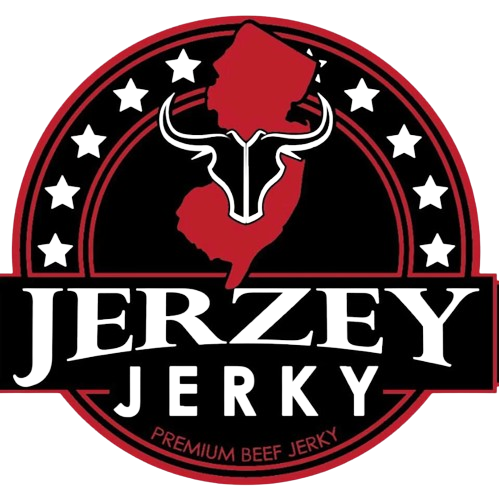
 2025-08-06
2025-08-06
 Wayne Holland
Wayne Holland
